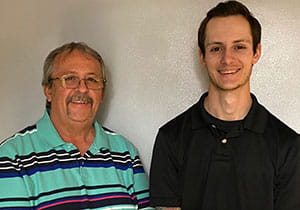The Challenge: Nonalcoholic Cirrhosis
After graduating from the University of Pittsburgh with a metallurgy engineering degree, Mark Sr. worked for four decades in the steel industry as an operations manager. In 2016, he knew something wasn’t right with his body. First, he developed a kidney stone that he couldn’t pass, then he developed a urinary tract infection and sepsis.
“I had a pretty aggressive disorder and I ended up needing to take antibiotics continuously for 44 straight days,” says Mark Sr., 61. “My body started to react to the medicine. I just didn’t feel right.”
The liver performs more than 500 functions and is one of the most vital organs because it purifies the body of toxins and germs. But too much damage over too many years can result in scarring, or fibrosis, that prevents the liver from working. In 2017, Mark was diagnosed with nonalcoholic cirrhosis of the liver: a transplant was his only option.
“Either the disease or the antibiotic — or both — damaged my liver. I lived, but it meant my liver wasn’t the same. It continued to deteriorate,” says Mark Sr.
The Path to UPMC’s Liver Transplant Program
With more than 14,000 Americans on the waiting list for a liver transplant — and only about 5,000 deceased-donor livers available for transplant — patients often wait years for an organ to become available.
Knowing he didn’t have years to wait for a liver from a deceased donor, Mark turned to UPMC for a second opinion. By then, his MELD (model for end-stage liver disease) score had risen steadily from the teens and into the 20s. The MELD score is a number that estimates the severity of your illness, with 40 being the most severe. It is calculated from the results of your pre-transplant evaluation.
“Once you reach a MELD score of 25, you need to be thinking about a transplant. My score was at 27,” says Mark.
Mark met with a transplant hepatologist with UPMC Transplant Services, who recommended a living-donor liver transplant.
The Solution: A Living Donor Transplant
Mark’s son, Mark Jr., was in North Dakota working on a drilling site for a fracking company when he got a phone call from his parents. After they explained the situation and how a living-donor liver transplant worked, Mark Jr. didn’t hesitate. “It was a no brainer,” he says. “I just wanted to help.”
The 24-year-old immediately returned home to southwestern Pennsylvania. He underwent a living donor evaluation to ensure he was a match and both physically and mentally prepared for the procedure.
“They literally test you for everything to make sure you’re healthy and a good candidate,” says Mark Jr.
“I didn’t worry too much about becoming a living donor. I wanted to do it — he’s my dad. And after coming down to UPMC to do the tests and seeing how much they care, I felt like I was in good hands.”
During a living-donor liver transplant, a piece of a healthy liver is removed from the donor and transplanted into the recipient to replace the failing liver. The procedure is possible because of the liver’s unique ability to regenerate.
Mark Jr. proved to be a perfect match. Surgery took place on Jan. 17, 2019.
“I can’t say enough good things about the care I received at UPMC,” says Mark Sr. “As an engineer, I could see the incredible planning and teamwork behind the transplant process. It runs like a fine-tuned watch.”
The Results: Back to Work and a Wedding Celebration
Today, both men have recovered from surgery and are doing well. The elder Mark returned to work after eight weeks. Mark Jr. was back on the job two weeks after surgery and is now living and working back in western Pennsylvania.
In October 2019, the whole family celebrated when Mark Jr. got married.
“Getting married after all this made it really special,” says Mark Jr. “My dad was there, and he was healthy. He was totally different from the man he was the year before. It was an amazing day for us all.”
“I’ve come to appreciate life a lot more. I learned there’s more to it than just work,” says Mark Sr. “My son giving me part of his liver — it was a lifesaver. I stared at death and my boy saved my life. I gave him life when he was born and he returned it. What a gift.”
Mark Sr.’s and Mark Jr.’s treatment and results may not be representative of all similar cases.

















